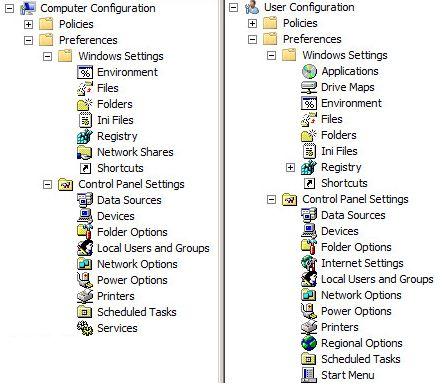Group Policy
Group Policy: Understanding Group Policy Preferences
Group Policy Preferences
Windows Server 2008 introduced Group Policy preferences, which are stored in Group Policy Objects (GPOs) but behave differently from policy settings in several key ways, including the following:
- Preferences can be overridden by users, unlike policy settings, which are strictly set by Group Policy and may not be modified.
- Policy settings are refreshed regularly – every 90 minutes by default. Preferences can either be refreshed on the same schedule or written only once. The latter options allows a preference setting to be modified by a user without reverting on the next refresh cycle.
- If a preference setting is removed from a GPO, the setting persists on the GPO’s targets (the users and/or computers to which the GPO applies). Policy settings, on the other hand, are removed from targets when they are removed from GPOs.
- Preferences may not be configured in a user’s or computer’s local GPO.
- Preferences require no Group Policy support from applications. Settings are written to the same registry locations that applications and the OS itself write to, whereas policy settings are written to the Policy branches of the registry.
- Preferences offer item-level targeting, which allows individual preference settings in a GPO to be applied to specific users or computers based on a wide variety of criteria.
- Original registry settings on the client are overwritten and removing the preference does not restore the original setting. In other words, a preference actually modifies the corresponding configuration setting in the user interface on the client. Because of this difference, policies can be effective only for features of Windows operating systems and applications that are Group Policy–aware, while preferences can be effective for any features of Windows operating systems and applications as long as the appropriate preference extension is loaded.
- Policies can be configured in both domain and local GPOs; preferences can be configured only in domain GPOs.
- A preference can be applied only once if desired; policies are always periodically refreshed.
Setting that can be configured via Group Policy preferences as following:
Scheduled Tasks
- Create, modify, or delete scheduled tasks.
Environment Variables
- Define environment variables for users and computers.
Registry:
- Manage registry settings on a per-user or per-computer basis.
Mapped Drives
- Configure mapped drives to shares on the network.
Local Users and Groups
- Create, modify, or delete local user accounts and security groups.
Printers
- Create, modify, or delete local or network printer objects, or share local printers to the network.
Files and Folders
- Distribute files and folders from a specified source to many machines on the network, or clean up existing files and folders on those machines.
The complete list of Group Policy preference categories as they appear in the console in Windows Server 2008 R2 is
shown below.

So, that’s all in this blog. I will meet you soon with next stuff .Have a nice day !!!
Recommended content
RODC Installation Guide- Step by step guide to install read only domain controller
RODC Filtered Attribute Set
Installing and configuring a RODC in Windows Server-2012
How to find the GUID of Domain Controller
Understanding Group Policy Preferences
Group Policy Verification Tool GPOTool Exe
Group Policy Health Check on Specific Domain Controller
Netlogon Folder in Active Directory
Custom Attributes in Active Directory
Tombstone Lifetime of My Active Directory Forest
Computers AD Site From the Command Line
Active Directory Database Integrity
Disabling and Enabling the Outbound Replication
DFS Replication Service Stopped Replication
Strict Replication Consistency
The replication operation failed because of a schema mismatch between the servers involved
Troubleshooting ad replication error 8418 the replication operation failed because of a schema mismatch between the servers
Replication information in txt file
Repadmin Replsummary
Enabling the outbound replication
Guys please don’t forget to like and share the post.Also join our WindowsTechno Community and where you can post your queries/doubts and our experts will address them .
You can also share the feedback on below windows techno email id.
If you have any questions feel free to contact us on admin@windowstechno.com also follow us on facebook@windowstechno to get updates about new blog posts.
Was this article helpful?
YesNo
